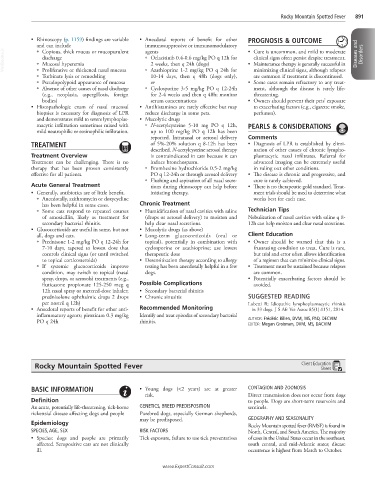Page 1774 - Cote clinical veterinary advisor dogs and cats 4th
P. 1774
Rocky Mountain Spotted Fever 891
• Rhinoscopy (p. 1159) findings are variable • Anecdotal reports of benefit for other PROGNOSIS & OUTCOME
and can include immunosuppressive or immunomodulatory • Cure is uncommon, and mild to moderate
VetBooks.ir ○ Mucosal hyperemia ○ Oclacitinib 0.4-0.6 mg/kg PO q 12h for • Maintenance therapy is generally successful in Diseases and Disorders
agents
○ Copious, thick mucus or mucopurulent
discharge
clinical signs often persist despite treatment.
2 weeks, then q 24h (dogs)
○ Proliferative or thickened nasal mucosa
are common if treatment is discontinued.
10-14 days, then q 48h (dogs only),
○ Turbinate lysis or remodeling ○ Azathioprine 1-2 mg/kg PO q 24h for minimizing clinical signs, although relapses
○ Pseudopolypoid appearance of mucosa or • Some cases remain refractory to any treat-
○ Absence of other causes of nasal discharge ○ Cyclosporine 3-5 mg/kg PO q 12-24h ment, although the disease is rarely life-
(e.g., neoplasia, aspergillosis, foreign for 2-4 weeks and then q 48h; monitor threatening.
bodies) serum concentrations • Owners should prevent their pets’ exposure
• Histopathologic exam of nasal mucosal • Antihistamines are rarely effective but may to exacerbating factors (e.g., cigarette smoke,
biopsies is necessary for diagnosis of LPR reduce discharge in some pets. perfumes).
and demonstrates mild to severe lymphoplas- • Mucolytic drugs
macytic infiltration sometimes mixed with ○ N-acetylcysteine 5-10 mg PO q 12h, PEARLS & CONSIDERATIONS
mild neutrophilic or eosinophilic infiltration. up to 100 mg/kg PO q 12h has been
reported. Intranasal or aerosol delivery Comments
TREATMENT of 5%-20% solution q 8-12h has been • Diagnosis of LPR is established by elimi-
described. N-acetylcysteine aerosol therapy nation of other causes of chronic lympho-
Treatment Overview is contraindicated in cats because it can plasmacytic nasal infiltrates. Referral for
Treatment can be challenging. There is no induce bronchospasm. advanced imaging can be extremely useful
therapy that has been proven consistently ○ Bromhexine hydrochloride 0.5-2 mg/kg in ruling out other conditions.
effective for all patients. PO q 12-24h or through aerosol delivery • The disease is chronic and progressive, and
○ Flushing and aspiration of all nasal secre- cure is rarely achieved.
Acute General Treatment tions during rhinoscopy can help before • There is no therapeutic gold standard. Treat-
• Generally, antibiotics are of little benefit. initiating therapy. ment trials should be used to determine what
○ Anecdotally, azithromycin or doxycycline works best for each case.
has been helpful in some cases. Chronic Treatment
○ Some cats respond to repeated courses • Humidification of nasal cavities with saline Technician Tips
of amoxicillin, likely as treatment for (drops or aerosol delivery) to moisten and Nebulization of nasal cavities with saline q 8-
secondary bacterial rhinitis. help clear nasal secretions. 12h can help moisten and clear nasal secretions.
• Glucocorticoids are useful in some, but not • Mucolytic drugs (as above)
all, dogs and cats. • Long-term glucocorticoids (oral or Client Education
○ Prednisone 1-2 mg/kg PO q 12-24h for topical), potentially in combination with • Owner should be warned that this is a
7-10 days, tapered to lowest dose that cyclosporine or azathioprine; use lowest frustrating condition to treat. Cure is rare,
controls clinical signs (or until switched therapeutic dose but trial and error often allows identification
to topical corticosteroids) • Desensitization therapy according to allergy of a regimen that can minimize clinical signs.
○ If systemic glucocorticoids improve testing has been anecdotally helpful in a few • Treatment must be sustained because relapses
condition, may switch to topical (nasal dogs. are common.
spray, drops, or aerosols) treatments (e.g., • Potentially exacerbating factors should be
fluticasone propionate 125-250 mcg q Possible Complications avoided.
12h nasal spray or metered-dose inhaler; • Secondary bacterial rhinitis
prednisolone ophthalmic drops 2 drops • Chronic sinusitis SUGGESTED READING
per nostril q 12h) Lobetti R: Idiopathic lymphoplasmacytic rhinitis
• Anecdotal reports of benefit for other anti- Recommended Monitoring in 33 dogs. J S Afr Vet Assoc 85(1):1151, 2014.
inflammatory agents; piroxicam 0.3 mg/kg Identify and treat episodes of secondary bacterial
PO q 24h rhinitis. AUTHOR: Frédéric Billen, DVM, MS, PhD, DECVIM
EDITOR: Megan Grobman, DVM, MS, DACVIM
Rocky Mountain Spotted Fever Client Education
Sheet
BASIC INFORMATION • Young dogs (<2 years) are at greater CONTAGION AND ZOONOSIS
risk. Direct transmission does not occur from dogs
Definition to people. Dogs are short-term reservoirs and
An acute, potentially life-threatening, tick-borne GENETICS, BREED PREDISPOSITION sentinels.
rickettsial disease affecting dogs and people Purebred dogs, especially German shepherds,
may be predisposed. GEOGRAPHY AND SEASONALITY
Epidemiology Rocky Mountain spotted fever (RMSF) is found in
SPECIES, AGE, SEX RISK FACTORS North, Central, and South America. The majority
• Species: dogs and people are primarily Tick exposure, failure to use tick preventatives of cases in the United States occur in the southeast,
affected. Seropositive cats are not clinically south central, and mid-Atlantic states; disease
ill. occurrence is highest from March to October.
www.ExpertConsult.com

